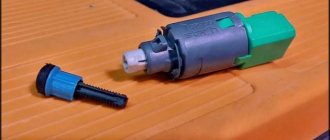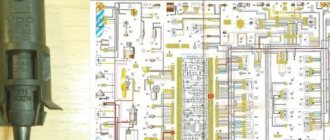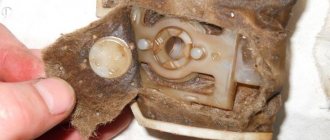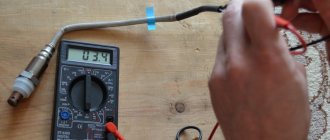What kind of device is this?
Such an element is present in any modern car, since the era of carburetor engines has passed and an electronic control unit (ECU), or controller in other words, is responsible for many operations. Many drivers even call him “the brain.”
The mass air flow sensor is used to measure the amount of air supplied to the engine. However, this device does not measure its volume, but only determines how much mass passes per unit of time, sending data to the ECU. In turn, the controller “understands” how much air has entered the cylinders at each moment of time, and depending on this, adjusts the fuel supply. As a result, the engine runs smoothly and without interruption.
Beginners may be interested not only in whether the mass air flow sensor can be cleaned, but, in fact, where it is located. Typically, this device is located in the area between the air filter housing and the pipe that goes to the throttle valve. It is equipped not only with gasoline, but also with diesel power units.
Preventing MAF Sensor Problems
For the most part, the MAF sensor in your car will work reliably without causing you any problems. When you need to replace the air filter or remove the air filter assembly for service or repair, or when you forget to service the air filter assembly, you may experience problems with the MAF's performance. Here are some tips you may want to keep in mind:
- Whenever you experience MAF problems, carefully inspect the intake boot and air filter housing for tears, damage, or loose connections that could allow air to bypass the MAF.
- When cleaning the sensor or replacing the air filter, make sure it is installed correctly. .
- If air gets to the throttle body without first measuring the MAF, your engine will not run properly and you will again experience engine performance issues.
- Replace the air filter at the manufacturer's recommended intervals and keep the air filter housing and air filter assembly in proper order. This helps prevent MAF contamination problems.
- If you frequently drive in dusty conditions, you may need to clean the MAF more often, such as every 50,000 miles or less, and replace the air filter more often.
From the following video you will learn where the MAF (vehicle mass air flow) sensor is located, how it works and how to clean it.
When is it time to clean?
But regardless of the type of sensor, over time it begins to function incorrectly due to contamination - the platinum measuring elements become covered with dust. Therefore, the question of how to clean the mass air flow sensor will always be relevant.
Why does this happen? The main reason for sensor contamination lies on the surface - the unsatisfactory condition of the air filter. If the filter element is of poor build quality, then it is not able to trap microscopic particles of dirt and dust that settle on the sensing element of the mass flow sensor.
As a result, the device is not able to accurately measure the amount of air and sends incorrect data to the ECU. It's not hard to imagine what this might lead to. Here we gradually approach some characteristic signs that may indicate that the sensor is clogged and needs to be cleaned:
- The need to clean the mass air flow sensor on a VAZ or other cars arises when the engine idles intermittently, in some cases they are too high - up to 1500.
- The car may jerk and have difficulty accelerating.
- Sometimes the engine does not start at all.
- Increased fuel consumption - sometimes up to 15 liters per 10 km.
- Check Engine light on the dashboard.
However, the above signs do not always accurately indicate contamination of the air flow sensor. A variety of situations can arise, and among them is one when the sensor itself is fine, but the fault lies in the hose that connects the device to the module.
In other words, although there are many obvious signs that a particular part of the car is faulty, they can indicate any other problem.
Mass air flow sensor VAZ 2114
The mass air flow sensor is necessary for efficient engine operation in different modes. The function of this device is to create a working mixture of air and gasoline vapor. The task of the VAZ 2114 air flow sensor is to measure two interrelated indicators:
- Amount of air consumed;
- Reaction time.
The accuracy of measuring the air consumption of the engine allows the controller to determine in what proportion it is necessary to mix air with fuel. If the sensor produces incorrect values, the resulting air-fuel mixture does not correspond to the current engine operating mode. This leads to a decrease in power, an increase in fuel consumption, and a deterioration in the dynamics and response of the car. The response of controllers from different manufacturers to these parameters may differ.
For example, January-5.1, in case of slight overestimation or underestimation of values, determines the error of the mass air flow sensor based on the readings of the oxygen sensor, thus adjusting the duration of fuel injection. Increasing the sensor response time will cause the controller to not keep up, and at the time of acceleration you will notice “dips” of the engine. The same sensor error when using a more sensitive Bosch controller will lead to floating idle speed, although there will be no noticeable dips during acceleration.
Sensor check
To accurately verify that the sensor is faulty and understand whether the mass air flow sensor on the VAZ-2114 needs to be cleaned or not, whether it needs cleaning or whether you will have to go to the store for a new mass air flow sensor, you will need a multimeter known to all radio amateurs:
- The device is switched to voltage measurement mode (voltmeter).
- Set the limit to 2 V.
- There are two wires in the sensor connector - yellow (it goes to the ECU) and green (connects to ground).
- The voltage is measured between these wires, and only the ignition should be turned on.
- Now all that remains is to look at the instrument readings.
If the measurement result is 0.99-0.02, the sensor is working. If the upper threshold is exceeded to 0.03, the mass air flow sensor needs cleaning and the sooner the better. In the case when the measurements are less than the lower limit (0.95) or the upper limit is very high (0.05), then the chances of a successful outcome are 50/50. That is, either cleaning will help and the sensor will function properly again, or you need to buy a new device.
In addition to this, you can understand whether to clean the mass air flow sensor on a VAZ-2110 or not by using one more method when you don’t have a multimeter at hand. Disconnect the sensor, then start the engine, raise the speed to 2000 and drive for a while. If at this moment there are obvious changes, the car has become more dynamic, then the sensor is definitely dirty.
Diagnostics
During diagnostics, first of all, the clamp holding the air supply pipe to the mass flow sensor is loosened. You will need a Phillips screwdriver here. The corrugation itself must also be inspected. Its inner surface must be clean and dry. The presence of traces of dampness or condensation indicates a failure of the air filter. Its malfunction usually leads to rapid failure of the mass air flow sensor.
Next, use a 10mm wrench to unscrew the sensor clamps, after removing which it is necessary to carry out an external inspection.
It is important to pay attention to the seal - it is normally located at the very edge of the flange. Displacement of it leads to contamination of the internal elements of the sensor
Checking the performance of the mass air flow sensor is carried out using a multimeter. The procedure is as follows:
- disconnect the terminal supplying the sensor;
- the tester probes are connected to the wires (red to yellow and black to green);
- in this situation, the mass air flow sensor begins to function in emergency mode, that is, the air supply occurs according to the latest data received from it.
- when the supply circuit does not close when the motor is turned on, then we can say with confidence: it is the sensor that is faulty.
- up to 1.02 – mass air flow sensor is working;
- up to 1.03 – slight wear;
- up to 1.04 – operability preserved;
- up to 1.05 is the maximum permissible norm.
Anything that exceeds the level of 1.05 volts indicates a breakdown of the sensor.
In addition, it is easy to verify that the mass air flow sensor is malfunctioning in this way:
- the control device is turned off;
- By car travel 2-3 kilometers.
If a noticeable improvement in engine performance is recorded, it means the sensor has failed.
Cleaning products
Since the sensing element of the air flow sensor is made of platinum, therefore, it is necessary to choose the right means to clean it. And first of all, it’s worth understanding what you absolutely cannot use:
- Any liquid that contains acetone, ketone, ether.
- Products used to clean carburetors.
- Cotton wool wound around a match, toothpick, etc.
- Compressed air.
What then remains to be used? Well, there are plenty of options here too.
What is the best way to flush the air flow sensor?
In fact, there are not many cleaning compounds that can be used to clean the air sensor - all the others will simply ruin it (see section above).
Therefore, the question: what is the best way to flush the air flow sensor can be answered quite specifically:
- pure medical ethyl alcohol that does not contain any impurities;
- carburetor cleaner (does not contain acetone);
- spray WD-40.
WD-40
At the same time, medical alcohol can be used either 96 degrees or diluted with distilled water in a ratio of 1 to 5.
Liqui Moly
How to clean the MAF sensor? One option is cleaning fluid from Liqui Moly. The company is known to many car enthusiasts as a manufacturer that makes only high-quality products for cars. In addition, the ratio between reliability and price is at an optimal level. As for the use of liquid for cleaning the mass air flow sensor, most vehicle owners have already become convinced of its effectiveness. This has not been proven by a single procedure. And if the sensor is in working condition, then even after cleaning it will last no less.
The liquid can be used for both diesel and gasoline engines.
What may indicate a problem
Repairing a cracked windshield: the subtleties of the process
Signs of possible problems with the sensor include:
- increased fuel consumption;
- drop in power and decrease in traction;
- deterioration in acceleration dynamics;
- problems starting the engine;
- floating idle speed;
- The Check Engine light on the instrument panel comes on.
The presence of these signs may indicate other problems. Therefore, it is better to conduct additional diagnostics of the air flow sensor.
Sensor diagnostics can be carried out in different ways. The simplest of them is to disconnect the power from it while the motor is running. After this you need to drive a little. If during this time an improvement in engine performance is observed, then the mass air flow sensor is faulty.
Alcohol
We can say that this is an old-fashioned method, which at the same time will never lose its relevance. Alcohol can effectively break down dirt and blockages. About 20 years ago, the question of how to clean the mass air flow sensor was mainly solved with the help of alcohol, and this method was held in high esteem by many drivers, but now they are trying to resort to it less and less.
Nevertheless, it is relevant in cases where the car owner needs to invoice for washing with special means. Unfortunately, such disappointing practice is not uncommon at many service stations.
Cleaning the air flow sensor on a VAZ.
For the so-called repair of the mass air flow sensor we will need:
- cleaning and rinsing liquids;
- syringe;
- flat screwdriver.
- We remove the mass air flow sensor. To find out how to remove the mass air flow sensor, read the article
- We unscrew the sensor element, which is attached to two special bolts. Such bolts can be unscrewed with a regular flat-head screwdriver.
- We take a syringe with liquid and at a distance of 5-10cm. spray on all parts of the sensor: contacts, diode, holes, etc.
- For prevention, we clean the wire connection block and their contacts.
- We rinse everything with the same syringe and let it dry.
- We install and check.
- If it does not help, then the process can be repeated again. If the sensor still does not work, you will have to buy a new one.
WD-40
Absolutely every car enthusiast is familiar with this product, regardless of experience. In addition, all other people who are not directly related to cars know about it. Over the course of its existence, WD-40 has proven itself to be excellent, and there is no doubt about its effectiveness.
For this reason, it is used not only to remove “deposits” from bolts, but also to clean the mass air flow sensor.
Video “Diagnostics of mass air flow sensor using a multimeter”
The video below presents another, more accurate method for diagnosing the performance of the sensor - using a tester (the author of the video is the Simple Opinion channel).
09.25.2012DFID
Opinions regarding washing the mass air flow sensor are ambiguous: some say that washing the mass air flow sensor helps, others simply ruin the sensor using this method. Our opinion is that the sensor can be washed, but very carefully, because... The air flow sensor is very sensitive, complex and sensitive. Moreover, it is not the entire plate that needs to be washed, but the small rectangular window under the air direction arrow. There is an anemometer and very thin contacts that go to it. These contacts are very sensitive and are easy to break and dissolve.
Therefore, it is strictly forbidden to use:
- compressed air;
- esters;
- ketones;
- matches, cotton swabs;
- aerosols containing acetone.
Regarding carburetor cleaners, the opinion is also not clear, because... for example, the service department writes that the sensor is washed with carburetor cleaner. But I wouldn't risk it, because... Mass air flow sensor is the most expensive of all sensors.
How to properly clean the air flow sensor
Let's consider the procedure for cleaning the mass air flow sensor using the example of a car of the 10th family - VAZ-2110:
- Turn off the ignition.
- Disconnect the connector from the mass air flow sensor.
- Remove the sensor itself by unscrewing the bolts that secure it to the air filter housing. Depending on the car model, disabling the mass air flow sensor may vary.
- The sensor is removed from its place, otherwise its cleaning will not be effective.
- On the device itself there is an area with two bolts - these should also be unscrewed.
- The selected cleaning agent is drawn into a syringe and then sprayed onto the sensitive element. At the same time, if necessary, you can wash the block with contacts.
- Give time for everything to dry.
- Assemble the sensor and install it in place.
To make drying faster, you can use a compressor only at minimum pressure. If the sensitive element is heavily soiled, the procedure should be repeated several times.
But even in this case, washing does not always give the desired result, and you just have to go to the nearest store for a new mass air flow sensor.
Cleaning the air flow sensor on a VAZ.
For the so-called repair of the mass air flow sensor we will need:
- cleaning and rinsing liquids;
- syringe;
- flat screwdriver.
- We remove the mass air flow sensor. To find out how to remove the mass air flow sensor, read the article
- We unscrew the sensor element, which is attached to two special bolts. Such bolts can be unscrewed with a regular flat-head screwdriver.
- We take a syringe with liquid and at a distance of 5-10cm. spray on all parts of the sensor: contacts, diode, holes, etc.
- For prevention, we clean the wire connection block and their contacts.
- We rinse everything with the same syringe and let it dry.
- We install and check.
- If it does not help, then the process can be repeated again. If the sensor still does not work, you will have to buy a new one.
Additional manipulations
It is now clear how to clean the mass air flow sensor, but this procedure alone does not end everything; it is necessary to perform a number of additional and necessary manipulations. And you need to do this before installing a clean device. And while the cleaning agent is drying, it’s time to work on the air pipe. It is worth carefully inspecting it for integrity. And if the condition is unsatisfactory - there are cracks and other damage, then it should be replaced.
As experts note, before installing the mass air flow sensor, it is advisable to replace the filter element. You should also check the condition of the rubber seal. Here it is important to pay attention to how tightly it fits, otherwise it will not be possible to avoid the suction of outside air, which is flooded with various contaminants. As a result, cleaning will be required again, and in a fairly short time. Or it will lead to its failure altogether.
Possible malfunctions of the mass air flow sensor: signs and causes
How to clean and rinse the mass air flow sensor? We will talk about this below, but first, let's look at the signs and causes of device malfunction. The parameters transmitted by the flow meter largely influence the formation of a combustible mixture, which is very important for any modern engine. If the device fails, this may also make it impossible to start the engine.
By what symptoms can you understand that it is time to change or clean the regulator:
- the appearance of the Check Engine indicator on the control panel;
- the fuel consumption of the car has increased;
- The power of the vehicle has decreased significantly; the car now needs more time to gain speed;
- the dynamics dropped, in particular when accelerating;
- the engine does not start, it is possible to start the power unit with great difficulty;
- If the car is idling or stopped at a traffic light, then the crankshaft speed may fluctuate.
As for the causes of the malfunction, there are several of them:
- The flow meter is clogged, this is quite normal, in this case you can wash it.
- The device is faulty; only replacement will solve the problem.
- Poor contact of the mass air flow sensor with the on-board network; this may be caused by damaged wiring.
Naturally, such symptoms of a breakdown may also indicate a malfunction of other systems and devices, which is why every car owner should be able to diagnose problems.
What is the difference between sensors 037 and 116?
How can the regulators of these models differ from each other and is it possible to install 116 instead of 037? There are differences between these controllers, and the point is not in the MAF pinout. After all, if these models were the same, what would be the point of giving them different names?
So, how do the controllers differ from each other and is it possible to install model 116 instead of 037:
- The first difference that can be guessed based on the technical characteristics is that the 037 model can produce data with an error during operation. Of course, an error of 2.5% is not critical, but it does exist.
- Device 037 is intended for installation in VAZ 2111, 2112, 2123, 21214 cars, which are equipped with controllers M 1.5.4, January 5.1-5.1.3, etc.
- As for model 116, its use is relevant on Ladas 21114, 21124, 21214. Installation of this device is allowed on Kalina and Priora. Installation of the device is allowed on cars equipped with M 7.9.7 and January 7.2 controllers.
If you encounter a problem with the device not working, then when replacing it you need to install the same model that has already been installed. But it is worth considering that 037 is not a common option like 116, so it is more difficult to find. The latter, in turn, is more common, and its cost is lower.
Replacement is allowed, but experts do not recommend this. This is because these devices differ in their calibration, so in case of replacement, you will have to change the parameters of the control unit. And you can only get into the “brains” of a car if you understand what needs to be done and have minimal experience.
Good day!
The subject is this: I have a VAZ 21140 2004 model year. with brains BOSCH 7.9.7. On it the mass air flow sensor died, the readings are 1.02-1.04, depending on the case, and secondary signs: the revolutions drop when the clutch is depressed to 500-600, increased fuel consumption (11-12l/100km), difficult cold starts.
Measuring voltage in the sensor
When repairing the mass air flow sensor in a VAZ 2110 with your own hands, you need to check the device using a special diagnostic device. If this is not possible, use a regular voltmeter. The scale should allow you to measure voltage with an accuracy of 0.01 volts. Measurements are taken between the sensor input and ground. The input is indicated by a yellow wire, and ground, as a rule, by a green wire. The optimal value is a voltage in the range from 0.99 to 1.01 V. If the mark shows a value higher, it’s time to repair the mass air flow sensor. To clean the sensor, you must first remove the unit mount. The factory fasteners look rather tricky; it makes sense to replace them with standard ones and a regular screwdriver.
The solvent will be carburetor cleaner. This is also convenient because the tube of the aerosol can fits perfectly into the resistor channel
We clean the resistor in several passes. Important: do not use matches, toothpicks, sharp sticks, or elegant rollers. Even a jet of compressed air can cause harm
After assembly, check the voltage again. If it is in the desired range, then the repair was successful.
Learn how to fix everything yourself
Download video
Which cleaner will kill the mass air flow sensor, and which one is safe for the mass air flow sensor - see for yourself. I did an EXPERIMENT with cleaners and decided for myself which cleaner can be used to clean the air flow sensor and which one cannot. And you decide for yourself - the choice and decision-making is purely individual. For Donat, Sponsors, order advertising https://www.youtube.com/consumer/SamiDlyaSebya1/about?disable_polymer=1 THANK YOU. The experiment involved: – 2 carburetor cleaners, one of which I called for myself “conditionally safe” for cleaning the mass air flow sensor, because of the inscription on the can “will not damage the oxygen sensor” – Special liquid for cleaning the mass air flow sensor – Liquid to make it easier to work with threaded connections – Plastic bath – Mass air flow sensor – Idle speed sensor – Throttle assembly In the end, I cleaned everything I needed. The result is excellent, it is shown at the end of the video.











